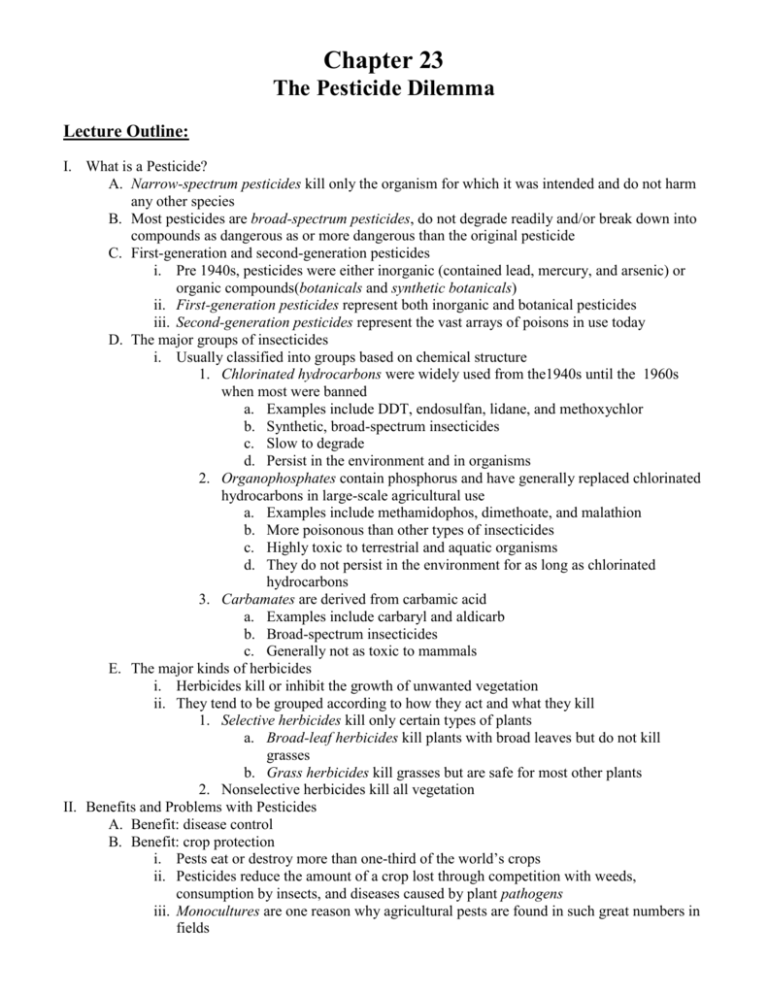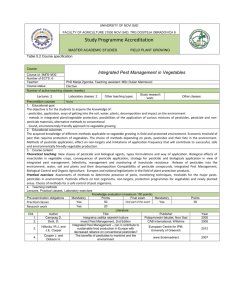Chapter 23 - Solon City Schools
advertisement

Chapter 23 The Pesticide Dilemma Lecture Outline: I. What is a Pesticide? A. Narrow-spectrum pesticides kill only the organism for which it was intended and do not harm any other species B. Most pesticides are broad-spectrum pesticides, do not degrade readily and/or break down into compounds as dangerous as or more dangerous than the original pesticide C. First-generation and second-generation pesticides i. Pre 1940s, pesticides were either inorganic (contained lead, mercury, and arsenic) or organic compounds(botanicals and synthetic botanicals) ii. First-generation pesticides represent both inorganic and botanical pesticides iii. Second-generation pesticides represent the vast arrays of poisons in use today D. The major groups of insecticides i. Usually classified into groups based on chemical structure 1. Chlorinated hydrocarbons were widely used from the1940s until the 1960s when most were banned a. Examples include DDT, endosulfan, lidane, and methoxychlor b. Synthetic, broad-spectrum insecticides c. Slow to degrade d. Persist in the environment and in organisms 2. Organophosphates contain phosphorus and have generally replaced chlorinated hydrocarbons in large-scale agricultural use a. Examples include methamidophos, dimethoate, and malathion b. More poisonous than other types of insecticides c. Highly toxic to terrestrial and aquatic organisms d. They do not persist in the environment for as long as chlorinated hydrocarbons 3. Carbamates are derived from carbamic acid a. Examples include carbaryl and aldicarb b. Broad-spectrum insecticides c. Generally not as toxic to mammals E. The major kinds of herbicides i. Herbicides kill or inhibit the growth of unwanted vegetation ii. They tend to be grouped according to how they act and what they kill 1. Selective herbicides kill only certain types of plants a. Broad-leaf herbicides kill plants with broad leaves but do not kill grasses b. Grass herbicides kill grasses but are safe for most other plants 2. Nonselective herbicides kill all vegetation II. Benefits and Problems with Pesticides A. Benefit: disease control B. Benefit: crop protection i. Pests eat or destroy more than one-third of the world’s crops ii. Pesticides reduce the amount of a crop lost through competition with weeds, consumption by insects, and diseases caused by plant pathogens iii. Monocultures are one reason why agricultural pests are found in such great numbers in fields C. Problem: evolution of genetic resistance i. The prolonged used of a particular pesticide can cause a pest population to evolve genetic resistance ii. At least 84 weed species are currently resistant to certain herbicides iii. The pesticide treadmill refers to the predicament in which the cost of applying pesticides increases (because they have to be applied more frequently or in larger doses) while their effectiveness decreases (as a result of increasing genetic resistance in the target pests) iv. Resistance management encompasses strategies for managing genetic resistance in order to maximize the period in which a pesticide is useful D. Problem: imbalances in the ecosystem i. Beneficial insects are killed as effectively as pest insects ii. Pesticides are indirectly responsible for a large reduction in the populations of natural enemies 1. They indirectly kill natural enemies due to large scale consumption of the pesticide when consuming the pests 2. Creation of new pests becomes possible because the pesticide kills most of a certain pest’s natural predators, parasites, and competitors E. Problems: persistence, bioaccumulation, and biological magnification i. Some pesticides are extremely persistent in the environment and may take many years to break down into less toxic forms 1. Persistent pesticides are stored in the fatty tissues of animals who ingest them 2. Bioaccumulation is the buildup of a persistent pesticide or other toxic substance in an organism’s body 3. The increase in pesticide concentrations as the pesticide passes through successive levels of the food web is known as biological magnification F. Problem: mobility in the environment i. Pesticides do not stay where they are applied but tend to move through the soil, water, and air ii. Pesticide mobility is a problem for both wildlife and humans 1. It can be lethal to aquatic organisms (i.e., fish), and/or cause bone degeneration, decrease their competiveness and increase their chances of being preyed upon 2. 14.1 million U.S. residents drink water containing traces of five widely used herbicides 3. Herbicides can elevate cancer risk in humans III. Risks of Pesticides to Human Health A. Exposure to pesticides is greater than most people realize and often occurs without their knowledge i. Short-term effect of exposure 1. Short-term exposure can harm organs and even cause death 2. A person with a mild case of pesticide poisoning may exhibit symptoms such as nausea, vomiting, and headaches a. Pesticides poison approximately 67,000 Americans each year b. Globally, 3 million people are poisoned by pesticides, 220,000 die 3. Almost any pesticide can kill a human if the dose is large enough ii. Long-term effects of pesticides 1. Long-term exposure can cause cancer 2. Exposure to even trace amounts can disrupt the human endocrine system 3. An association between various cancers and long-term exposure to low levels of pesticides has been shown in many studies 4. Other health concerns such as sterility, birth defects, miscarriages in pregnant women have been linked to long-term pesticide exposure IV. Alternatives to Pesticides A. Alternative ways to control pests include cultivation methods, biological controls, pheromones and hormones, reproductive controls, genetic controls, quarantine, and irradiation B. Integrated pest management (IPM), which combines various alternative methods of pest control, is the most effective way to control pests C. Using cultivation methods to control pests i. Using an insect vacuum, interplanting mixtures of plants, and strip cutting are effective cultivation methods used to control pests ii. The proper timing of planting, fertilizing, and irrigating promote healthy, vigorous plants that are more resistant to pests, because they are not stressed by other environmental factors D. Biological controls i. A method of pest control that involves the use of naturally occurring disease organisms, parasites or predators to control pests is referred to as a biological control 1. More than 300 species have been introduced as biological control agents to North America 2. Finding an effective parasite or predator is difficult ii. The pest species typically does not evolve genetic resistance to the biological control agent the same way it does to pesticides iii. Nematodes and fungi as biological control agents 1. Nematodes are effective against mosquitoes, corn borers, weevils, grasshoppers, and locusts 2. Fungal spores can target desert locusts iv. Problems with biological control 1. Attack of an unintended host 2. Make sure it does not become a pest itself E. Pheromones and hormones i. Pheromones can be used to control individual pest species ii. Synthetic hormones have been used to trigger abnormal molting in insect larvae F. Reproductive controls i. Reproductive control strategies suppress pests by sterilizing some of its members ii. The sterile male technique helps to control the reproductive potential of the pest population so that the population of the next generation is much smaller G. Genetic controls i. Many varieties of crops have been selectively breed to be genetically resistant to disease organisms or insects 1. Through traditional selective breeding techniques this can take as long as 10-20 years 2. Plant breeders are in a continual race to keep one step ahead of plant pathogens ii. Genetic engineering can produce genetically modified (GM) plants that are pestresistant in fewer generations H. Quarantine i. Governments attempt to prevent the importation of foreign pests and diseases by practicing quarantine ii. It is an effective, though not foolproof, means of control I. The systems approach: integrated pest management (IPM) i. IPM is a combination of control methods is often more effective than controlling pests with a single technique 1. IPM combines a variety of biological, cultivation, and pesticide controls tailored to the conditions and crops of an individual farm, campus, city, or greenhouse 2. IPM requires a thorough knowledge of the system, including life cycles, feeding habits, travel, and nesting habits of the pests as well as their interactions with their hosts and other organisms ii. IPM is the management rather than the eradication of pests; it requires that farmers be educated J. Irradiating foods i. Food irradiation or cold pasteurization prevents insects and other pests from damaging harvested food by exposing it to ionizing radiation ii. Irradiation lessens the need for pesticides and food additives V. Laws Concerning Pesticide Use A. Food, Drug, and Cosmetics Act (FDCA – 1938) i. Pesticide Chemicals Amendment (1954), aka the Miller Amendment, requires the establishment of acceptable and unacceptable levels of pesticides in food ii. The Delaney Clause (1958) states that no substance capable of causing cancer in test animals or in humans would be permitted in processed food B. The Federal Insecticide, Fungicide, and Rodenticide Act (FIFRA – 1947) i. Regulates the effectiveness of pesticides ii. A 1988 amendment required reregistration of older pesticides and subjected them to the same toxicity tests that new pesticides face C. Food Quality Protection Act (1996) i. This Act amended both the FDCA and FIFRA ii. It requires that the increased susceptibility of infants and children to pesticides be considered when establishing pesticide residue limits for some 9,700 pesticide uses on specific crops iii. It also reduces the time it takes to ban a pesticide considered dangerous from 10 years to 14 months VI. The Manufacture and Use of Banned Pesticides A. Some U.S. companies manufacture pesticides that are banned or heavily restricted in the U. S. and export them to developing countries for use B. The U.N. Food and Agriculture Organization (FAO) is attempting to help developing nations become more aware of dangerous pesticides C. The importation of food tainted with banned pesticides i. Some of the food imported into the U.S. contains traces of banned pesticides such as DDT, dieldrin, chlordane, and heptachlor ii. The FDA inspect only about 1% of the food shipments that enter the U.S. each year D. The global ban of persistent organic pollutants i. The Stockholm Convention on Persistent Organic Pollutants (2004) seeks to protect human health and the environment from the 12 most toxic chemicals (persistent organic pollutants) ii. It only applies to countries that have ratified the treaty








